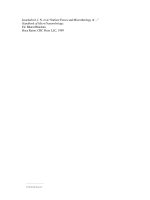Handbook of ultraviolet and visible absorption spectra of organic compounds (1967)
Bạn đang xem bản rút gọn của tài liệu. Xem và tải ngay bản đầy đủ của tài liệu tại đây (19.78 MB, 647 trang )
Handbook of Ultraviolet and
Visible Absorption Spectra
of Organic Compounds
Kenzo Hirayama
Fuji Photo Film Research Laboratories
Odawara, Japan
PLENUM PRESS DATA DIVISION • NEW YORK • 1967
Library of Congress Catalog Card Number 66-24948
©1967 Plenum Press Data Division
A Division of Plenum Publishing Corporation
227 West 17 Street, New York, N. Y. 10011
All rights reserved
No part of this publication may be reproduced in any
form without written permission from the publisher
Printed in the United States of America
Contents
Introduction .........................................................................................................................
1
Explanation on Notation and Arrangement ......................................................................
4
Table 1. Absorption Maximum from Chemical Structure ................................................
9
Abbreviations and Symbols ..............................................................................................................
9
List of Chromophores ........................................................................................................................
10
1.
No Chromophore .......................................................................................................................
20
2.
(C:C)-Chromophores .................................................................................................................
23
3.
(C:C)-Chromophores and Cumulenoid Chromophores ............................................................
31
4.
(N:N)-, (O-N:N)-, and (N:N:N)-Chromophores ..........................................................................
35
5.
(N:C)-Chromophores .................................................................................................................
36
6.
(N:C),- (N:C:N)-, and (N:N:C)-Chromophores ...........................................................................
50
7.
(O:C)-Chromophores .................................................................................................................
51
8.
(O:C-N)-Chromophores .............................................................................................................
69
9.
(O:C-O)-Chromophores .............................................................................................................
71
10. Other (O:C-X)-Chromophores and (O:C:C)-Chromophores .....................................................
82
11. (O:N)- and (O:N-O)-Chromophores ..........................................................................................
84
12. Other Aliphatic Chromophores ..................................................................................................
87
13. Metallocene- and (X:X:5:X)-Chromophores ..............................................................................
88
14. (6)-Chromophores without Other Conjugated Unit Chromophores ..........................................
89
15. (6)(C:C)-, (6)(C:C)-, and (6)(Cumulenoid)-System ................................................................... 120
16. (6)(N:N)-, (6)(O-N:N)-, and (6)(N:N:N)-System ......................................................................... 128
17. (6)(N:C)-System ......................................................................................................................... 142
18. (6)(N:C)-, (6)(N:C:C)-, and (6)(P:P)-System ............................................................................. 153
19. (6)(O:C)-System ........................................................................................................................ 155
20. (6)(O:C-N)-System .................................................................................................................... 182
21. (6)(O:C-O)- and Other (6)(O:C-X)-Systems .............................................................................. 184
22. (6)(O:N)-System ........................................................................................................................ 200
23. (6)(O:N-O)-System .................................................................................................................... 202
This page has been reformatted by Knovel to provide easier navigation.
vii
viii
Contents
24. Other Aromatic Systems with (6) ............................................................................................... 225
25. (X:6:X)-Chromophores .............................................................................................................. 226
26. (7:X)- and (X:X:7:X)-Chromophores .......................................................................................... 233
27. (65:X)-, (66)-, and (X:66:X)-Chromophores .............................................................................. 238
28. Other Chromophores Consisting of 2 Carboaromatic Condensed Rings ................................ 267
29. Chromophores Consisting of 3 Carboaromatic Condensed Rings .......................................... 274
30. Chromophores Consisting of 4 Carboaromatic Condensed Rings .......................................... 292
31. Other Carboaromatic Chromophores ........................................................................................ 308
32. (N5)-Chromophores ................................................................................................................... 319
33. (N6)-and (N6:X)-Chromophores ................................................................................................ 322
34. (N65)-, (N65:X)-, and (X:N65:X)-Chromophores ...................................................................... 338
35. (N66)-, (N66:X)-, and (X:N66:X)-Chromophores ...................................................................... 345
36. Other N1 Aromatic Chromophores ............................................................................................ 362
37. (N25)-, (N25:X)-, (X:N25:X)-, and (X:X:N25:X)-Chromophores .................................................. 372
38. (N26)-, (N26:X)-, and (X:N26:X)-Chromophores ........................................................................ 376
39. Other N2-Aromatic Chromophores ............................................................................................ 401
40. N3-Aromatic Chromophores ...................................................................................................... 415
41. N4-Aromatic Chromophores ...................................................................................................... 423
42. Other Aromatic Chromophores with N Hetero-atoms ............................................................... 441
43. Aromatic Chromophores with P or As Hetero-atom(s) ............................................................. 443
44. (O5)-and (X:O5:X)-Chromophores ............................................................................................ 444
45. (O6)-and (O6:X)-Chromophores ............................................................................................... 453
46. Other Aromatic Chromophores with O Hetero-atom(s) ............................................................ 457
47. Aromatic Chromophores with O and N Hetero-atoms .............................................................. 469
48. Aromatic Chromophores with S Hetero-atom(s) ....................................................................... 480
49. Aromatic Chromophores with S and N Hetero-atoms .............................................................. 492
50. Other Heteroaromatic Chromophores ....................................................................................... 506
Table 2. Absorbing Chromophore from Absorption Maximum ...................................... 509
λmax.: <199.5mµ... - ...λmax.: 263-263.5mµ ......................................................................................... 509
λmax.: 264-264.5mµ... - ...λmax.: 316-316.5mµ .................................................................................... 544
λmax.: 317-317.5mµ... - ...λmax.: 365-365.5mµ .................................................................................... 577
λmax.: 366-366.5mµ... - ...λmax.: 800mµ~ ............................................................................................ 595
References .......................................................................................................................... 616
This page has been reformatted by Knovel to provide easier navigation.
INTRODUCTION
Ultraviolet and visible absorptions of organic compounds are characteristic of
absorbing systems that consist of a so-called chromophore group and the auxochromic groups
bonded to it, rather than the chemical structure of the molecule as a whole.
For example, the ultraviolet absorption maximum of the cholestadienone isomer (I) is
close to that, of (II), but entirely different from those of the other isomers, (III), (IV),
and (V)o However, it is very close to the absorption maximum of a nonsteroidal,
4-methyl-6-(2,6,6-trimethyl-2-cyclohexenyl)-3,5-hexadien-2-one (VI). This is natural
because the absorbing system is the same in (I), (II), and (VI), but is quite different
from those of (III), (IV), and (V)0
(I) cholesta-4,6-dien-3-one
(II)
*2Sf 277m^
*max* 285m^ <lo§e 4'4>
(III)
cholesta-1,4-dien-3-one
(IV)
(VI)
X
maxH
242ra
^ (loB£4'°)
(1
°S£ 4'4)
cholesta-4,7-dien-3-one
X^XH 238my (loge 4.2)
AjJOH 245my (logs 4.2)
(V) cholesta-7,14-dien-3-one
cholesta-3,5-dien-7-one
4-methyl-6-(2,6,6-trimethyl-2cyclohexenyl)-3,5-hexadien-2-one
xJaJH 285my (loge 4.2)
Studies of ultraviolet and visible absorption spectra started long before the study
of infrared absorption spectra, and a far larger number of spectral measurements is
available. Still, they have not been fully utilized for the identification of organic
compounds and the most important reason for this state of affairs is that these data have
not been organized from the point of view of the absorbing system, as outlined above.
Having realized the need for such a collection of data, the writer collected,
classified, and published such data as a part of "Yuki Kagaku Teisu Binran," a volume in
"Dai Yuki Kagaku" (Series of Comprehensive Organic Chemistry, 25 vols. with an index
volume, Asakura Shoten, Tokyo, 1960-1963).
In that publication, rules were proposed for notation and for the order of the absorbing systems. The collection of data was certainly useful in utilizing ultraviolet and
visible absorption spectra, but it included only a table for identifying absorption maxima
from absorbing systems and no table in which the absorbing systems could be found from
the absorption maxima, which would be the most convenient method for structural identification.
This shortcoming has now been corrected, and the revised and enlarged version that has
been compiled for the present edition does contain a tabulation according to absorption
maxima.
Table I is a list from which absorption maxima can be found from the absorbing systems,
i.e., from the chemical structure. In general, the absorption of strongest intensity in a
range of about 50my in wavelength was taken as the absorption maximum. Consequently, the
distance between two absorption maxima is usually more than 50my.
This table is used in the following manner. To look for the absorption maximum of
cholesta-4,6-dien-3-one (I), we look under the absorbing system
O' C~C' C~-C' C-C
'i *±
The order of the arrangement of absorbing systems is explained in detail under "Explanation
of Notation and Arrangement." The desired absorbing system can be found directly from
Table I by following this order of arrangement, or the chromophore group in this absorbing system (O!C-C'.C—C'.C in the above example) can be found from the "List of Chromophores"
from which the compound number of (0:C)(C:C)2 is found as 772-831.
Table II is a reverse index of Table I. It is a list of absorbing systems to be
found from the wavelengths of absorption maxima.
Ultraviolet and visible absorptions of organic compounds can be determined approximately from the absorbing system, but the solvent used and measurement error must also be
taken into account. Consequently, it is better to examine the wavelength regions around
the desired wavelength.
For example, if an unsaturated ketone having no substituent other than one keto
group has an absorption maximum at 285my (loge 4.42) in ethanol, the following absorption
maxima in a range of 285±5my can be found from Table II.
(0:C)(C:C)
<0:C)(CrC)2
loge
no .
loge
no.
4.0
4.0
717
756
4.2
3.9
4.3
794
812
828
4.4
3.3
727
757
4.4
804
-2my = 283my
-Imp = 284my
±0my = 285my
4.4
815
4.1
3.8
648
713
4.3
4.2
4.4
797
806
807
+lmy = 286my
4-2my = 287my
4.3
719
4.4
4.4
4.5
4.4
4.4
4.2
783
827
799
807
808
793
795
805
813
^•max.
-5my = 280my
-4my = 281my
-3my = 282my
+3my = 288my
-f-4my = 289my
+5my = 290my
4.1
4.1
(OrC)(CrC)3
(OrC)(CrC)6
loge
no.
loge
no .
4.1
850
4.1
869
Examination of the absorbing system of these compounds from compound numbers in Table
I shows that the (0:C)(C:C) group, and compounds 783, 827, and 828 in the (OrC)(CrC)2 group
are not the desired systems, because they have auxochromes
joined to the chromophore. The (OrC)(CrC)^ group has a
stronger absorption maximum at 393my (loge 4.8) and is
not the desired system. Further, compounds 793, 794, 795,
797, and 799 of the (0:C)(CrC)2 group are dienal and are
therefore unsuitable. Consequently, the absorbing systems
that remain are those which include compounds 804, 805, 806,
807, 808, 812, 813, and 815, i.e., a dienone of
°:9"°:C~~°:C type, with two or three
alkyl auxochromes, or a trienone of type (VII) with a steric hindrance like compound 850.
These conclusions are based on the chemical observation that there is no hetero-atom
in the molecule other than the oxygen atom in the keto group and on spectral observations
of the absorption maximum and intensity, but the possible absorbing systems can be further
narrowed by comparing ultraviolet absorption curves.
Grateful acknowledgement is made to Dorothy U. Mizoguchi for her cooperation in preparing the manuscript.
Kenzo Hirayama
EXPLANATION
ON NOTATION
AND ARRANGEMENT
ABSORBING SYSTEM
An absorbing system consists of a chromophore or conjugated chromophores, printed in
bold face type in Table I, and an atom or atoms, if any, joined to the chromophore or conjugated chromophores, and sometimes, consists merely of auxochromic atoms.
e.g.
compound
absorbing system
notation
Rules determine the notation and sequence of absorbing systems, as mentioned below.
PRINCIPLE OF CITING AND ARRANGING ABSORBING SYSTEMS
Rule 1. The more predominant factor in an absorbing system is cited as early as
possible. Absorbing systems having a more predominant factor are placed later in the
tables.
For example, C:C predominated over C:C as mentioned in Rule 3, and therefore the
chromophore of butenyne is denoted such as CiC - CiC (not CiC - CiC), and CiC precedes CiC
in the tables.
PREDOMINANCY OF ATOMS AND BONDS
Rule 2. The order of increasing predominancy of atoms or elements is as follows:
H,C, and other atoms in the order of ascending group number of the Periodic Table
and increasing atomic number in the group.
Rule 3.
The order of increasing predominancy of bonds is as follows:
single bond < coordinate bond < double bond < triple bond
(An expression a < b indicates that b predominates over a.)
NOTATION OF UNIT CHROMOPHORE
1. Aliphatic chromophores are denoted by atomic symbol and sign of unsaturated bonds.
e.g.
CiC CiC CiCiC NiN N i N i N NiC NiC N i C i N
PiP OiN OiCiC OiAs SiC SiCiS SiCiN SiCiO
Nitro and azoxy chromophores are denoted as Q i N an<3 N i N > respectively. Chromo-
O
O
phores of carboxylic acid (including ester), and its derivatives of type -CO-X such as
amide, halide, and thiolic acid (including ester) are regarded as an unit chromophore
and denoted as:
OiC
OiC
OiC
OiC
6
ft
61
s
Chromophores of carbonic acid (including ester), and its derivatives such as
H2N-CO-NH2, H2N-COOH, (HS)2CO, COCl2 are regarded also as an unit chromophore and denoted
as
OiCO2,
0'.CN2,
OiCON,
OiCS2,
OiCCI 2 .
2. Benzene chromophore is denoted by Arabic numeral 6, and carboaromatic condensed
chromophores are denoted by Arabic numerals with or without subscript Arabic numerals,
respectively indicating the number of atoms in each ring and the number of rings, cited
in the decreasing order of the numerals denoting number of atoms.
e.g. naphthalene 66, azulene 75, indacene 655, anthracene and phenanthrene 63
3. Heteroaromatic chromophores are denoted by atomic symbol with or without subscript Arabic numerals, respectively indicating the kind and number of the hetero-atom,
and the notation of the corresponding carboaromatic chromophore.
e.g. thiophene S5, pyridine N6, indene N65, pyrimidine N26, purine N^65,
thiazole SN5, benzothiazole SN65
4. Fulvenoid, quinonoid, and tropoquinonoid structures are denoted by symbols representing the corresponding genuine aromatic chromophore, the exocyclic double bond(s),
and the atom(s) joined to the exocyclic double bond(s).
e.g. methylenecyclopentadiene (fulvene) 5*.C, dihydropyridinone (pyridone) NGiO,
pyranone (pyrone) 06.'O, tropone 7iO, methyleneindole N65iC, benzoquinone diimine N'.6iN, naphthoquinone Oi66iO, dihydromethylenefuranone (methylenecrotonolactone)
0.05.C, tropoquinone ^i 7!O
PREDOMINANCY OF UNIT CHROMOPHORE
Rule 4. The predominancy of unit chromophores is determined by applying the following criteria in series until-a decision is reached.
a) Heteroaromatic unit chromophores predominate over carboaromatic unit chromophores, which predominate over aliphatic unit chromophores.
e.g. CiC < 66 < N6
b) The predominancy of heteroaromatic unit chromophores is determined first by
hetero-atoms contained in the ring, from the point of (i) the predominancy of the most
predominant hetero-atom and, if there is a choice, of the subsequent predominant heteroatom(s), (ii) a larger total number of hetero-atoms, and (iii) a larger total number of
the most predominant hetero-atom and, if there is a choice, the subsequent predominant
hetero-atom(s).
Examples for (i) :
N6iS < 05, N665 < 065 < S5, 06 < ON5, ON5 < OP5
for (ii):
SN65 < SN265
for (iii): SN265 < S2NSS, SeSN2665 < SeS2^eS
c)
The most predominant is that containing a larger total number of rings.
e.g. 6 < 75 < 63, SN5 < SN65, O i 6 i O < 66
d)
The most predominant is that containing a larger ring.
e.g. 5iO < 6 < 7iO, 55 < 65iO < 66 < 75 < 76iO, N5 < N6 < N7iO
e) The predominancy increases with the sequence of genuine aromatic, fulvenoid,
quinonoid, and tropoquinonoid structures.
e.g.
6 < 0.6.0,
7iO < £i7iO,
N6 < N6iO < OiN6iO
f) The predominancy of aliphatic unit chromophores is determined first by componental atoms, from the point of (i) the predominancy of the most predominant componental
atom and, if there is a choice, of the subsequent predominant componental atoms(s), (ii)
a larger total number of componental atoms joined with unsaturated bond(s), and (iii) a
larger total number of the most predominant componental atom and, if there is a choice,
of the subsequent predominant componental atom(s).
Examples for (i) :
for (ii):
for (iii):
g)
CiC < NiN < NX < OiC < OiN < O i C i N < O i A s
CiC < C i C i C , OiC < OiCiC, OiC < OiCiO, N i C < N i C i N
NiCiC < NiCiN
The most predominant is that containing a more predominant bond.
e.g.
CiC < CiC, NiC < NiC
h) The more predominant is that containing a larger total number of a more predominant componental atom(s) joined with coordinate bond(s) or a single bond(s) to the
atom joined with unsaturated bond(s) and, if there is a choice, the subsequent predominant componental atom(s) similarly joined.
e.g.
OiC < OiC < OiCN 2 < OiC < OiCON < OiC < OiCS2 < OiCSO < OiC < OiCCI 2 ,
OiN < OiN, NiN < NiN
A
O
NOTATION OF CONJUGATED CHROMOPHORES
Conjugated chromophores are denoted by the notation of componental unit chromophores
joined by a hyphen.
e.g.
CiC-CiC,
OiC-CiC-CiO,
OiC-66-CiC,
Q*.£>N66-CiO
When there is a choice, the direction is so chosen as to make the most predominant
chromophore and, if there is a choice, the subsequent predominant chromophore(s) come
as early as possible.
N * r*
e.g.
CiC-CiC,
OiC-6
OiC-NiC-CiC,
Oi(T^0'
NiC<£:£
6-CiC, CiC-6-CiC, 6e-6, Ne-6, S6-6-N6
Sometimes, the notation of unit chromophores in conjugation may be reversed, such as
N i C to CiN in 6-C:N.
NOTATION OF AUXOCHROMIC ATOMS
Auxochromic atoms are denoted by atomic symbol(s) joined by a hyphen to the atom in
the chromophore. Hydrogen atom is not regarded as an auxochrome, and not necessary to be
denoted.
^
e.g.
C-CiC-CiC-C, NiC-C, 0-NiC-C2 (not 0-NiC<c>, OC-6,
C1-N6
When there is a choice, the direction is so chosen as to make the symbol of the most
predominant auxochromic atom, and if there is a choice, that of the subsequent predominant auxochromic atom(s), come as early as possible.
e.g.
C-CiC-CiC (not CiC-CiC-C)5 CiC-CiC (not CiC-CiC)
Cl
Cl
CiC-CiC-C (not C-CiC-CiC), C-CiC-CiC (not CiC-CiC-C)
ii
ii
ii 61
ci ci
NOTATION OF LONG CONJUGATED ABSORBING SYSTEMS
In addition to the above measures, sometimes, long conjugated absorbing systems may
be denoted in an abbreviated manner.
e.g.
(CiC)5~C4 instead of C-CiC-CiC-CiC-CiC-CiC-C
£
i
&-[CiC]5-6 instead of 6-CiC-CiC-CiC-CiC-CiC-S
NOTATION AND ARRANGEMENT OF AUXOCHROMIC SYSTEM WITHOUT CHROMOPHORE
Auxochromic systems such as methane, chloromethane and bromomethane, have no chromophore, and they are treated as absorbing systems of no chromophore.
PREDOMINANCY OF ABSORBING SYSTEMS
Rule 5. The predominancy of absorbing systems is determined by applying the follow-
ing criteria in series until a decision is reached.
a) The predominancy is determined first by the most predominant unit chromophore
and, if there is a choice, the subsequent predominant unit chromophore(s), contained in
the absorbing system, from the point of (i) being predominant, (ii) being larger in total
number, and (iii) being cited earlier.
Examples for (i) :
CiC-CiC-CiC < CiC-CiC < CiC-CiC < NiC-CiC-CiC < 6 < S-C.O <
NiSiC-S < N6-c:c
for (ii):
for (iii):
OiC-CiC-CiC < OiC-CiC-CiC-CiC < OiC-CiC-CiO
CiC-CiC-CiC < CiC-CiC-CiC, NiC-CiC-CiC < NiC-CiC-CiC
b) The predominancy is determined by earlier appearance of (i) the most predominant
atom and, if there is a choice, the subsequent predominant atom(s), in the most predominant unit chromophore, and of (ii) the most predominant atom and, if there is a choice,
the subsequent predominant atom(s), in the subsequent predominant unit chromophore(s).
Examples for (i) : CiN-CiC < NiC-CiC
for (ii):
NiC-CiC-CiN < NiC-CiC-NiC
c) The predominancy is determined by the most predominant auxochromic atom and, if
there is a choice, the subsequent predominant auxochromic atom(s), joined to the most
predominant atom in the most predominant unit chromophore, from the point of (i) being
predominant, (ii) being larger in total number, and (iii) being cited earlier.
Examples for (i):
C-NiC-CiC < N-NiC-CiC < 0-NiC-CiC,
BrN-S-CiC < BrCl-G-CiC
for (ii):
ClC3-S-CiC < Cl2C-S-CiC, ClC-S-CiC < ClC2-S-CiC
for (iii): CiC-CiC < C-CiC-CiC
Criteria (c) to (f) determine the predominancy of absorbing systems by the nature
of auxochromic atoms joined to the chromophores. When applying these criteria, the predominancy of C atoms of carboaromatic and heteroaromatic unit chromophores is -regarded
as same as that of C atoms of CiC, and the predominancy of hetero-atoms of heteroaromatic
unit chromophores is regarded as higher than that of C atoms of CiC and lower than that
of C atoms of CiCiC, in order to make the determination by these criteria accord with the
optical properties of absorbing systems.
e.g. C-S-CiC-CiCiC < S-CiC-CiCiC-C, Br-S-CiN-N < Cl-fr-CiN-0
d) The predominancy is determined similarly to (c) by the most predominant auxochromic atom and, if there is a choice, the subsequent predominant auxochromic atom(s),
joined to the subsequent predominant atom(s) in the most predominant unit chromophore.
e.g. C 2 -NiC-CiC < C 2 -NiC-CiC
e) The predominancy is determined similarly to (c) by the most predominant auxochromic atom and, if there is a choice, the subsequent predominant auxochromic atom(s),
joined to the most predominant atom in the subsequent predominant unit chromophore(s).
e.g. NiC-CiC-CiN-N < NiC-CiC-CiN-O
f) The predominancy is determined similarly to (c) by the most predominant auxochromic atom and, if there is a choice, the subsequent predominant auxochromic atom(s),
joined to the subsequent predominant atom(s) in the subsequent predominant unit chromOphore(s).
e.g. NiC-CiC-CiN-C 2 < NiC-CiC-CiN-C2
NOTATION AND ARRANGEMENT OF CROSS-CONJUGATED CHROMOPHORES
The direction denoting cross-conjugated chromophores is so chosen as to make the
most predominant linear conjugation and, if there is a choice, to make the subsequent
predominant linear conjugation(s) come as early as possible.
<•*- o:c
linear conjugation.
TABLE I
ABSORPTION MAXIMUM FROM CHEMICAL STRUCTURE
ABBREVIATIONS
A
AA
Ac
B
C
cH
CD
D
E
EA
H
Hp
iO
iP
L
M
PB
PE
Py
THF
V
W
AND
alcohol
acetic acid
acetone
benzene
chloroform
cyclohexane
carbon dioxide
dioxan
ether
ethyl acetate
hexane
heptane
isooctane or trimethylpentane
isopropanol
liquid
methanol
petroleum benzine
petroleum ether
pyridine
tetrahydrofuran
vapor
water
Numbers in the column
f
SYMBOLS
T
solv.T indicate pH-value.
An expression a/b concerning to solvent means
a f in T b', e.g. NH3/A.
Italicized numbers in columns 'A1113x.' and T loge f
in Table I indicate value for inflection or shoulder
of absorption.
LIST OF CHROMOPHORES
chromophore
no .
chromophore
no.
Part 1 . No chromophore
1- 54
(CrCrCrCrCrC)
301
( C r C r C r C r C r C r C r C r C r C ) 302
Part 2. (C:C)-Chromophores
(C:C)
55- 85
(CiC)2
86- 153
(C:C)3
154- 181
(CrC)4
182- 197
(C:C)5
198- 202
(CrC)6
203- 206
(C:C)y
207- 208
(C:C)8
209- 210
(CrC)9
211- 215
(CrC)10
216- 217
(CrC)Il
218- 220
(CrC)l2
221- 222
(CrC)i3
223- 225
(CrC)i4
226
(CrC)i5
227- 228
(CrC)I9
229
Part 4. (N:N)-, (N:N)-, and
O
(N:N:N)-Chromophore
(NrN)
303- 304
(NrN)
305- 307
O
(NrNrN)
308
Part 3. (CiC)-Chromophores
& Cumulenoid Chromophores
(CrC)
230- 232
(CfC)2
233- 235
(CiC)3
236- 237
(CrC)4
238
(CrC)5
239
(CrC)6
240
(CrC)y
241
(CrC)(CrC)
242- 257
(CrC)(CrC)2
258- 268
(CrC)(CrC)3
269- 271
(CrC) (CrC)4
272- 273
(CiC)(CrC)6
274
(CrC)(CrC)IO
275
(CrC)(CrC)Ii
276
(CrC)(CrC)I2
277
(CrC)2(CrC)
278- 281
(CrC)2(CrC)2
282
(CiC)2(CrC)4
283- 284
(CiC)2(CrC)6
285
(CrC)3(CrC)
286
(CrC)3(CrC)2
287- 288
(CrC)3(CrC)3
289
(CiC)4(CrC)2
290
(CfC)5(CrC)2
291
(CiC)6(CrC)2
292
(CrCrC)
293- 296
(CrCrC)2
297- 298
(CrCrC)(CrC)2(CrC)2
299
(CrCrCrC)
300
Part 5. (NrC)-Chromophores
(NrC)
309- 374
(NrC)2
375- 392
(NrC)(CrC)
393- 474
(NrC)(CrC)2
475- 508
(NrC)(CrC)3
509- 525
(NrC) (CrC)4
526
(NrC) (CrC)5
527- 528
(NrC)(CrC)6
529- 536
(NrC)(CrOy
531- 534
(NrC)(CrC)8
535- 536
(NrC)(CrC)9
537- 538
(NrC)(CrC)Ii
539
(NrC)2(CrC)
540
(NrC)2(CrC)2
541- 544
(NrC)2(CrC)4
545- 546
(NrC)2(CrC)6
547- 548
(NrC)2(CrC)8
549- 551
(NrC)2(CrC)9
552
(NrC)(CiC)
553- 554
(NrC)(CrC)2
555- 556
(NrC)(CiC)(CrC) 557- 558
(NrC)(CrC)(CrC)2 559- 562
(NrC)(CiC)(CrC)3
563
Part 6. (NiC)-, (N:C:N)-,
& (N:N:C)-Chromophores
(NrC)
564- 569
(NrC)2
570
(NiC)(CrC)
571- 575
(NiC)(CrC)2
576
(NrC)(CrC)3
577- 578
(NiC)2(CrC)
579
(NiC)2(CrC)2
580
(NrCrN)
581
(NrNrC)
582- 584
Part 7. (0:C)-Chromophores
(OrC)
585- 618
(OrC)2
619- 631
(OrC)3
632- 633
chromophore
no .
(OrC)(CrC)
(OrC)(CrC)2
(OrC)(CrC)3
(OrC)(CrC)4
(OrC)(CrC)5
(OrC)(CrC)6
(OrC)(CrC)7
(OrC)(CrC)8
(OrC)(CrC)9
(OrC)(CrC)10
(OrC)(CrC)U
(OrC)(CrOi2
(OrC)2(CrC)
(OrC)2(CrC)2
(OrC)2(CrC)3
(OrC)2(CrOy
(OrC)2(CrC)8
(OrC)2(CrC)9
(OrC)2(CrC)IO
(OrC)2(CrC)U
(OrC)2(CrOi2
(OrC)(CiC)
(OrC)(CrC)(CrC)
(OrC)(CiC)(CrC)2
(OrC)(CiC)(CrC)3
(OrC)(NrC)
(OrC)(NrC)2
(OrC)(NrC)(CrC)
(OrC)(NrNrC)
Part 8.
634772832853860868874878882892897902916920924928935939943946949953958968971-
771
831
852
859
867
873
877
881
891
896
900
901
915
918
919
923
927
934
938
942
945
948
952
956
957
967
970
972
973
(OrC)-Chromophores
fi
974- 981
(OrC)
N
(OrC)(CrC)
N
(OrC)(CrC)2
N
(OrC)(NrC)
N
(OrCN2)
982- 987
988
989- 995
996
Part 9. (0:f)-Chromophores
(OrC)
6
(OrC)2
O
(OrC)(CrC)
6
(OrC)(CrC)2
6
999-1010
1011
1012-1075
1076-1087
chromophore
no .
(OrC)(CrC)3
1088-1090
(OrC)(CrC)4
6
(OrC)(CrC)5
(J
(OrC)(CrOy
d)
(OrC)(CrOi2
O
(OrC)2(CrC)
1091-1096
6
(OrC)2(CrC)2
1097-1099
1100-1102
1103-1105
1106-1124
1125-1137
(OrC)2(CrC)3
1138-1142
(OrC)2(CrC)4
O
(OrC)2(CrC)5
O
(OrC)2(CrC)7
O
(OrC)2(CrC)9
O
(OrC)(CiC)
1143
1144
1145-1148
1149-1150
1151
(OrC)(CiC)2
O
(OrC)(CiC)3
1152
1153
(O:^) (CrC)(CrC)3
O
(OrC)(CiC)(CrC)4
O
(OrC)2(CiC)2(CrC)7
1155
(OrC)(CrCrC)
1157
(OrC)(NrC)
1154
1156
1158-1159
(OrC)(NrC)(CrC)2
1160
6
(OrC)(NrC)(CrC)5
O
1161-1162
(OrC)(NrC)(CrC)6
O
1163-1164
(Or(^) (NrC) (CrC)7
O
1165-1168
(OrC)(NrC)(CrC)8
6
1169-1172
(OrC)2(NrC)(CrC)
1173
O
(OrC)(NrC)(CrC) 1174-1181
A
chromophore
no .
(OrC)(NiC)(CrC)2
O
1182-1187
(OrC)(NiC)(CrC)3
O
1188-1190
(OrC)(NrNrC)
1191
6
(OrC)(OrC)
1192
6
(OrC)(OrC)(CrC) 1193-1197
6
(OrC)(OrC)(CrC)5
O
1198-1199
(OrC)(OrC)(CrC)6
O
1200-1202
(OrC)(OrC)(CrC)7
O
1203-1207
(OrC)(OrC)(CrC)8
O
1208-1210
(OrC)(OrC)(CrC)9
O
1211-1213
(OrC)2(OrC)(CrC)2
O
1214-1215
(OrC)(OrC)(NrC) 1216-1217
O
(OrC)(OrC)(CrC)2
1218
6
N
(OrCO2)
1219
Part 10. Other (OrC)-
i
Chromophores and
(0:C:C)-Chromophore
(OrC)
1220-1232
(OrC)
Cl
(OrC)2
Cl
(OrC)
Br
(OrC)2
Br
(OrCrC)
Part 11.
1233-1235
1236
1237
1238
1239-1240
(OrN)- and (OrIJI)O
Chromophores
1241-1261
1262-1287
(OrN)
(OrN)
O
(OrN)(CrC)
O
(OrN)(CrC)2
O
1288-1297
1298
chromophore
(OrN)(NrC)
6
no .
1299
Part 12. Other aliphatic
Chromophores
(SrC)
1300-1314
(SrCrS)
1315
(SrCrN)
1316
(SrCrO)
1317
Part 13. Metallocene- and
(yJ5:X) -Chromophores
Ar
(5-M)
(5-M)(OrC)
(^;5rO)
1318
1319
1320-1322
Part 14. (6)-Chromophores
without other conjugated
unit Chromophores
(6)
1323-1854
(6)2
1855-1956
(6)3
1957-1965
(6)4
1966-1971
(6)5
1972-1975
(6)6
1976
(6)9
1977
(6)10
1978
(6)u
1979
(6)i2
1980
(6)13
1981
(6)14
1982
(6)15
1983
(6)i6
1984
Part 15. (S)(CrC)-,
(B)(CiC)-, and
(6 HCumulenoid) -System
(6) (CrC)
1985-2053
(6) (CrC)2
2054-2058
(6) (CrC)3
2059
(6) (CrC)4
2060
(6)2(CrC)
2061-2096
(6)2(CrC)2
2097-2109
(6)2(CrC)3
2110-2111
(6)2(CrC)4
2112-2115
(6)2(CrC)5
2116
(6)2(CrC)6
2117
(6)2(CrC)7
2118
(6)3(CrC)
2119-2121
(6)3(CrC)2
2122-2124
(6)3(CrC)4
2125
(6)4(CrC)
2126
(6)4(CrC)2
2127-2130
chromophore
(6)4(C:C)4
(6)4(C:C)5
(6)4(C:C)6
(6) (CrC)
(6)2(C:C)
(6)2(C:C)2
(6)2(CrC)3
(6)2(C:C)4
(6)2(C:C)5
(6)2(C:C)8
(6)4(C:C:C)
(6)4(C:C:C:C)
(6)4([C:]5C)
(6)4([C:]7C)
no .
2131-2132
2133
2134
2135-2136
2137
2138
2139
2140
2141
2142
2143
2144
2145
2146
Part 16.
(6)(N:N)-,
(6)(N:N)-, and
O '
(6)(N:N:N)-System
(6)(N:N)
2147-2153
(6)2(N:N)
2154-2351
(6)3(N:N)
2352-2363
(6)3(N:N)2
2364-2378
(6)4(NrN)2
2379-2383
(6)4(N:N)3
2384-2388
(6) 5 (N: N) 4
2389-2394
(6)(N:N)
2395-2400
(6)2(N:N)
2401-2404
6
(6)3(N:N) (N:N) 2405-2407
A
(6)4(N:N) (NrN)2
A
(6)(N:N:N)
(6)(N:N:N)2
2408
2409
2410
Part 17. (6)(N:C)-System
(6)(N:C)
2411-2496
(6) (NrC)2
2497-2498
(6)2(NrC)
2499-2526
(6)2(NrC)2
2527-2561
(6)2(NrC)4
2562
(6)3(NrC)
2563-2565
(6)3(NrC)2
2566-2567
(6)4(NrC)2
2568-2580
(6)6(NrC)2
2581
(6) (NrC) (CrC)
2582-2597
(6) (NrC) (CrC)2 2598-2599
(6)2(NrC) (CrC) 2600-2606
(6)2(NrC) (CrC)2
2607
(6)2(NrC)2(CrC)
2608
(6)2(NrC)2(CrC)2
2609-2610
(6)2(NrC)2(CrC)3
2611
chromophore
no.
(6)2(NrC)2(CrC)4
(6)3(NrC)2(CrC)2
(6)3(NrC)2(CrC)4
(6)4(NrC) (NrN)
2612
2613
2614
2615
Part 18.
(6)(N:C)-,
(6)(N:C:C)-9 and
(6)(P:P)-System
(6) (NrC)
2616-2631
(6) (NrC) (CrC)
2632-2636
(6)2(NrC) (CrC) 2637-2641
(6) (NrC) (NrN)
2642-2645
(6)3(NrCrC)
2646
(6)2(P:P)
2647
Part 19. (6)(0:C)-System
(6) (OrC)
2648-2836
(6) (OrC)2
2837-2856
(6)2(OrC)
2857-2910
(6)2(OrC)2
2911-2931
(6)3(OrC)
2932
(6)3(OrC)2
2933-2934
(6)4(OrC)
2935-2936
(6)4(OrC)2
2937-2941
(6)4(OrC)3
2942
(6) (OrC) (CrC)
2943-3011
(6) (OrC) (CrC)2 3012-3022
(6) (OrC) (CrC)3 3023-3027
(6) (OrC) (CrC)4 3028-3031
(6) (OrC) (CrC)5 3032-3035
(6) (OrC) (CrC)6 3036-3039
(6) (OrC)2(CrC) 3040-3043
(6)2 (OrC) (C : C) 3044-3091
(6)2(OrC) (CrC)2 3092-3101
(6)2(OrC) (CrC)3 3102-3106
(6)2(OrC)(CrC)4 3107-3111
(6)2(OrC) (CrC)5 3112-3115
(6)2(OrC) (CrC)6 3116-3119
(6)2(OrC)2(CrC) 3120-3122
(6)2(0:C)2(C:C)6
3123
(6)2(OrC)2(CrC)8
3124
(6)3(OrC) (CrC)
3125
(6)4(OrC)4(CrC)
3126
(6) (OrC) (CrC)
3127-3128
(6) (OrC) (NrN) (CrC) 3129
(6)2(OrC)(NrC)(CrC) 3130
Part 20.
(6)(0:C)-System
(6) (OrC)
N
(6) (OrC)2
N
(6)2(0:
id
3131-3145
3146-3149
3150-3151
chromophore
(6) (OrC) (CrC)
N
(6)2(OrC) (CrC)
N
(6) (OrC) (NrN)
N
(6)2(0:C) (NrN)
N
Part 21.
no .
3152-3157
3158-3159
3160-3161
3162-3164
(G)(OrC)-
and other
(6)(0:C)-System
X
(6) (OrC)
3165-3303
(6) (OrC)2
3304-3321
(6) (OrC)3
O
(6) (OrC)4
3322
(6)2(OrC)
A
(6)2(OrC)2
O
(6) (OrC) (CrC)
(6) (OrC) (CrC)2
3323
3324-3326
3327-3331
3332-3364
3365-3369
(6) (OrC)2(CrC)2 3370-3371
O
(6)(OrC)2(CrC)3 3372-3373
O
(6)2(OrC) (CrC) 3374-3385
O
(6MOr(^)(CrC)
3386-3387
O
(6) (OrC) (NrN)
3388-3396
O
(6)2(OrC)2(NrN) 3397-3398
6
(6J2(OrCp2(NrN) 3399-3400
(6)2(OrC)(NrC)(CrC) 3401
O
(6)2(OrC) (NiC) (CrC)
O
3402-3405
(6) (OrC) (OrC)
3406-3407
O
(6) (OrC)2(OrC) 3408-3409
O
(6)2(OrC)(OrC) 3410-3411
chromophore
no .
(6)(0:C)(0:C)(C:C)
O
3412-3441
(6) (OrC) (OrC)
3442
O
N
(6) (OrC)
3443-3446
(6)(0:C)
3447-3448
ii
Part 22. (6)(0:N)-System
(6)(0:N)
3449-3477
(6) (OrN)2
3478
Part 23. (6)(0:N)-System
O
(6) (0:1^)
3479-3669
O
(6) (OrN)2
3670-3719
6
(6) (OrN)3
3720-3737
(6)2(OrN)
3738-3753
(6)2(OrN)2
3754-3759
(6)2(0rlj04
3760-3762
O
(6) (OrIjJ) (CrC)
3763-3801
O
(6) (OrN)2(CrC) 3802-3806
O
(6) (OrN)2(CrC)2 3807-3810
O
(6)2(OrN)3(CrC)
3811
O
6)2(OrN) (NrN) 3812-3838
O
(6)2(OrN)2(NrN) 3839-3844
(!)
(6)3(OrN) (NrN)
3845
0
(6)3(OrN)2(NrN)2
3846
6
(6) (OrN) (NrC)
3847-3849
6
(6)2(OrN)2(NrC)2
O
3850-3856
(6)2(Orlp)2(NrC)2(CrC)2
O
3857
(6J2(OrN)2(NrC)2(CrC)4
O
3858
(6) (OrN) (NrC) (NrN) 3859
O
(6) (OrN) (OrC)
3860-3875
O
chromophore
no .
(6)(OrN)2(OrC)
3876
i
(6)2(OrN) (OrC) 3877-3878
(6)3(OrN)(OrC)(CrC)
O
3879-3882
(6) (OrN) (OrC) (NrN) 3883
O
N
(6) (OrN) (OrC)
3884-3895
(6) (OrN)2(OrC) 3896-3898
O
6
(6) (OrN)3(OrC)
3899
O
O
(6) (OrN) (OrC) (CrC)
3900
6
O
(6) (OrIjI) (O :N)
3901
O
(6) (OrN) (OrN) (OrC) 3902
O
O
Part 24.
Other aromatic
Systems with (6)
(6)(AsrO)
3903
(6) (SrC)
3904
(6)2(S:C)
3905-3911
(6) (NrCrS)
3912
(6)2(5rO)
3913
Part 25.
(X:6:X)Chromophores
(Nr6rN)
3914-3919
(Nr6rN)
3920-3922
(Nr6rN)(6)
(Nr6rN)(6)2
3923
3924-3927
(Nr6rN)(6)2(OrN)2
3928
(N:6:N:N)
3929-3935
(Nr6rC)(6)
3936
(Nr6rC)(6)2
3937-3942
(Nr6rC)(6)3
3943-3944
(N:6:C)(6)4
3945
(Or6rO)
3946-4005
(0:6:0)2
4006
(0:6rC)
4007
(Or6rC)(6)
4008-4009
(Or6rC)(6)2
4010-4020
(Or6rC)(6)2(OrC)
4021
O
(0:6:N)
4022-4037
(Or6rNrN)
4038
chromophore
no .
Part 26. (7:X)- & (j[:7:X)Chromophores
(7rO)
4039-4061
(7rO)2
4062
(7rO)(OrC)
4063
6
(7:0) (OrC) (CrC)
4064
(7:0) (6)
4065-4081
(7:0) (6) (CrC) 4082-4086
(7rO)(6)(OrC)(CrC)
O
4087-4090
(7 rO) (6) (OrN)
4091-4092
O
(7:0) (6) (OrN) (OrC) (CrC)
4093-4094
(£;7rO)
4095
Part 27. (65:X)-, (66)-, &
(X:66:X)-Chromophores
(65rC)(6)
4096
(65rC)(6)(CrC)
4097
(66)
4098-4219
(66)2
4220-4230
(66) (CrC)
4231-4239
(66)2(C:C)
4240
(66)2(CrC)2
4241-4243
(66)2(NrN)
4244-4246
(66)2(NrN)
4247-4249
6
(66) (NrC)
4250-4252
(66)2(NrC)2
4253-4259
(66) (OrC)
4260-4285
(66) (OrC) (CrC) 4286-4292
(66) (OrC) (CrC)2 4293-4294
(66) (OrC)2(CrC)
4295
(66) (OrC)
4296-4309
6
(66) (OrC)2
4310-4313
6
(66)2(OrC)2
4314-4315
(66) (OrC) (CrC)
4316-4326
(66) (OrN)
(66) (OrIjI)
O
(66) (6)
(66)(6)2
(66)2(6)
(66) (6) (CrC)
(66) (6) (CrC)2
(66) (6) (CrCrC)
4327-4345
4346-4352
4353-4368
4369
4370
4371
4372-4373
4374-4375
chromophore
no .
(66)(6)(N:N)
4376-4413
(66)2(6)2(N:N)2
4414
(66)(6)(N:N)
4415-4417
(66)(6)(N:C)2
4418
(66)(6)2(N:C)
4419-4424
(66)2(6)2(N:C)2
4425
(66)(6)(0:C)
4426-4434
(66)(6)3(0:C)
4435
(66)(6)(0:£)
4436-4442
(66)(6)(0:C)2
4443-4444
(66)(6)2(0:C)
4445
(66)(6)(0:C)(C:C)
4446
(66)(6)(0:C)(N:N)
4447
(66)2(N:6:N)
6
O
(66) (N: 6 :N) (6)
4448
(N: 66: N)
(0:66:0)
(0:66:0) (C:C)
(0:66:0) (0:C)
4449
4450
4451-4512
4513-4519
4520
(0:66:0) (6)
4521
(0:66:0) (6) (C:C)
4522
(0:66:0) (66)
4523
(0:66:N)
4524
(0:66:N:N)
4525-4527
Part 28. Other Chromophores
consisting of 2 carboaromatic condensed Rings
(75)
4528-4570
(75)(C:C)
4571-4573
(75)(0:C)
4574-4575
(75) (0:0)
4576-4586
O
(75) (OrC)2
4587
(75)(0:N)
A
(75) (6)
(75)(6)(N:N)
(75)(6)(0:C)
(75) (66)
4588-4590
4591-4594
4595
4596
4597
Part 29. Chromophores consisting of 3 carboaromatic condensed Rings
(665)
4598
chromophore
no .
(665) (0:C)
4599-4600
(665:665)
4601-4602
(665:C)
4603-4605
(665:C:C:665)
4606
(665:[C:]3C:665)
4607
(665:[C:]5C:665)
4608
(665:N)
4609
(665:0)
4610-4614
(665:0) (0:C)
4615
N
(665:0) (0:C)
4616-4619
(0:665:0)
4620
(63)
4621-4692
(63)(C:C)
4693-4696
(63)4(C:C)
4697
(63) (NiC)
4698
(63)(0:C)
4699-4701
(63)(0:C)(C:C) 4702-4703
(63)(0:C)
4704-4705
(63)(0:C)(0:C)
4706
chromophore
(635)(0:C)
N
(635)(0:C)
A
(635:C)(0:C)
(635:N)
(635:0)
(0:635:0)
(64)
(64)(C:C)
(64) (N-C)
(64)(0:C)
(64)(0:C)
N
(64)(0:C)
no .
4890
4891
4892
4893-4895
4896-4899
4900
4901-5011
5012-5014
5015-5021
5022-5028
5029-5030
5031-5038
(64) (0:0) (0:0)
5039
O
(64) (O: IjI)
5040-5041
O
(64)(N:C:0)
5042-5043
(64) (6)
5044-5045
(64) (6)2
5046
(64) (6)3
5047-5049
(64) (6)4
5050-5051
(64:0)
5052
(0:64:0)
5053-5055
(7665)
5056
(7665) (0:N)
5057
A
(763)
5058
(63) (0:0) (0:0)
4707
Cl
(63)(0:N)
4708
O
(63)(6)
4709-4720
(63)(6)2
4721-4722
(63)(6)4
4723
(63)(6)2(N:C) 4724-4725
(63) (6) (0:0)
4726
N
(63)(66)
4727-4728
Part 31 . Other carboaromatic Chromophores
(63)(66)2
4729
(0:63:0)
4730-4837
(645)
5059-5062
(O : 63 :0) (N -C)
4838-4839
(645) (NiC)2
5063
(O : 63 :0) () :N)
4840-4845
(645) (0:C)2
5064
A
(0:63:0) (6)
4846
(645:0)
5065
(0:63:0) (6)
4847-4851
(65)
5066-5091
(0:63:C)(6)2
4852-4865
(65) (NiC)
5092
(65) (0:0)
5093-5094
(65)(N:C:0)
5095-5096
Part 30. Chromophores consisting of 4 carboaro(65)(6)2
5097
(65 :0)
5098-5104
matic condensed Rings
(765)
4866
(O: 65:0)
5105
(765) (0:C)
4867
(6452)
5106
O
(655)
5107-5108
(765) (6)
4868-4869
(66)
5109-5135
(6655)
4870
(66:0)
5136
(6655) (NlC)2
4871
(0:66:0)
5137
(6552)
5138
(6655) (6)2
4872
(6655:0)
4873-4874
(67)
5139-5161
(635)
4875-4889
(68)
5162-5181
chromophore
(6752)
(69)
(610)
(6952)
(611)
no .
5182
5183-5189
5190-5191
5192
5193
Part 32. (N5)-Chromophores
(N5)
5194-5201
(N5)(0:C)
5202-5210
O
(N5) (OrC)2
5211-5219
O
(N5) (OrC) (0:C) 5220-5221
(N5) (OrC)2(OrC)
(N5)(6)
(N5)(6)2
(N5)(6)3
(N5)(6)(0:C)
5222
5223-5228
5229-5230
5231
5232-5237
(N6)- and (N6:X)Chromophores
(N6)
5238-5373
(N6)2
5374-5392
(N6)(C:C)
5393-5406
(N6)2(C:C)
5407
(N6)2(N:N)
5408-5409
(N6)(0:C)
5410-5413
(N6)(0:C)(C:C) 5414-5415
(N6)(0:C)
5416-5419
A
(N6)(0:C)
5420-5434
chromophore
(N6rN)
(N6rO)
(N6rO)(6)
no .
5500-5503
5504-5549
5550-5551
Part 34. (N65)-, (N65:X)-,
& (X:N65:X)-Chromophores
(N65)
5552-5575
(N65)(OrC)
5576-5579
(N65)(OrC)
5580
(N65)(OrN)
(N65)(6)(OrC)
(N65)(Or6rO)
(N65)2(Or6rO)
(N65)(Or66rO)
(N65)(Or66rO)2
(N65rC)(6)
(N65rC)(N65)
(N65rO)
(OrN65rO)
(OrN65rC)
(OrN65rC)(OrC)
5581-5582
5583
5584-5586
5587
5588-5592
5593
5594
5595
5596
5597-5607
5608-5611
5612
Part 33.
(N6) (OrC)2
5435-5436
(N6)2 (OrC)2
5437-5438
(N6) (6)
5439-5442
(N6)(6)2
5443-5448
(N6)(6)3
5449-5454
(N6) (6) (CrC)
5455-5460
(N6) (6) (CrC)2
5461-5462
(N6)(6)2(CrC)2 5463-5465
(N6)(6)3(CrC)3
5466
(N6)2(6) (CrC)2 5467-5470
(N6) (6) (NrN)
5471-5482
(N6)(6)(OrC)
5483
(N6) (6) (OrC) (CrC)
5484
(N6) (N5)
5489-5493
(N6rC)
5494
(N6rC) (NrC)
5495
(N6rC)(6)
5496-5497
(N6rC)(6)2
5498-5499
(O rN65 rN65 rO)
5613-5649
(OrN65rN65rO) (OrC)2 5650
(OrN65rN65rO)(Orlff)2
5651-5652
(OrN65rN65rO)(6)2
5653
(OrN65rN65rO)(6)2(OrC)2
5654
(SrN65rN65rS)
5655
Part 35. (N66)-, (N66:X)-,
& (X:N66:X)-Chromophores
(N66)
5656-5805
(N66)2
5806-5808
(N66) (NrN)
5809-5810
(N66) (OrC) (NrNrN)
5811
(N66)(OrC)
5812
(N66) (OrIjJ)
5813-5820
(N66)(6)
5821-5826
(N66)(6)(CrC)
5827-5832
(N66) (6) (CrC)2 5833-5836
(N66) (6) (CrC)3
5837
(N66) (6) (CrC)4
5838
(N66) (6) (CrC)6
5839
(N66)(6)(0r(p
5840-5841
(N66)(6)2(OrC)
5842
(N66)(6)(OrN)
O
5843
chromophore
no .
(N66) (6) (O rN)2 5844-5846
6
(N66rC) (NrC)
5847-5848
(N66rC)(6)(NrC)
5849
(N66rC) (6) (NrC) (CrC)
5850-5851
(N66rC)(Nr6rC) 5852-5853
(N66rC)(Nr6rC) (CrC) 5854
(N66rC)(N6)
5855-5857
(N66rC)(N66)
5858
(N66rC)(N66) (CrC)
5859
(N66rN)(N66)
5860
(N66rN)(N66)(NrC)
5861
(N66rO)
5862-5901
(N66rO)(OrC)
5902-5903
(N66rO)(OrC)
5904-5908
6
(N66rO)(6)
5909-5913
(N66rS)
5914-5916
(N66rS)(OrC)
5917
6
(N66rS)(6)
5918
(OrN66rO)
5919
Part 36. Other Ni-aromatic
Chromophores
(N75)
5920
(N75) (NrC)
5921-5922
(N75rO) (NrC)
5923-5924
(N75rO)(OrC)
5925-5926
(N665)
(N665)(OrC)
N
(N665)(OrN)
(N665)(OrN)
5927-2949
5950
5951
5952-5955
(N665) (OrN)2
5956-5957
6
(N665) (OrN) (OrN)
5958
(N665)(6)
(N665)(6)(OrC)
(N63)
(N63) (NrC)
(N63)(0rlfl)
5959
5960
5961-6025
6026
6027-6031
(N63) (6)
6032-6035
(N63rC) (NrC)
6036
(N63rC)(N6)
6037-6038
(N63rC)(N66)
6039-6040
(N63rC)(N63)
6041-6042
(N63rC)(N63) (CrC)
6043-6044
chromophore
(N63rO)
(N635)
(N64)
(N645)
(N65)
(o>65;o)
no .
6045-6046
6047-6049
6050-6063
6064-6066
6067
6068
Part 37. (N25)-, (N2SrX)-,
(X:N25:X)-, and
Y•
(v;N
25:X)-Chromophores
A '.
(N25)
(N25)(0:C)
(N25)(6)
(N25)(6)3
(N25)(6)4
(N25)(6)(0:C)
(N25)(6)(0:(j:)
6069-6070
6071
6072-6080
6081
6082
6083
6084
(N25)(6)(0:C)
6085
(!)
(N25) (6) (O :N)
6086-6091
6
(N25:C)(6)4(0:C)2
6092-6093
(N25:0)(6)
6094-6095
(N25:0)(6)(0:N)
6096
(0:N25:C)
6097-6099
(0:N25:C) (6)
6100-6105
(°;N25rC)(6)
6106-6123
(SrN25;°)(6)
6124-6129
Part 38. (N2G)-, (N26:X)-,
& (X:N26:X)-Chromophores
(N26)
6130-6361
(N26) (N:N:N)2 6362-6365
(N26)(N:C)
6366
(N26) (NrC)
6367-6369
(N26)(0:C)
6370-6372
6
(N26) (Or(^)2
6373
O
(N26)(6)
6374-6384
(N26)(6)(C:C)
6385
(N26)(6)(C:C)2
6386
(N26)(6)(C:C)3
6387
(N26)(6)(C:C)4
6388
(N26) (6) (CrC)5
6389
(N26)(6)(C:C)6
6390
(N26) (6) (CrC)7
6391
(N26)(6)(NrN)
6392
(N26) (6) (NrNrN)2
6393
chromophore
no .
(N26) (6) (OrN) (NrC) 6394
6
(N26rO)
6395-6513
(N26rO)(6)
6514-6526
(N26rO)(6)2
6527
(N26rO)(6)(NrN)
6528
(N26rO)(6)(NrC)
6529
(N26rO)(6)(OrN) 6530-6534
(N26rS)
6535-6564
(OrN26rO)
6565-6600
(OrN26rO) (OrC) 6601-6603
A
(OrN26rO) (OrN) 6604-6606
6
(OrN26rO)(6)
6607
(SrN26rO)
6608-6623
(SrN26rS)
6624-6629
Part 39. Other N2-aromatic
Chromophores
(N265)
6630-6645
(N265) (NrC)
6646-6648
(N265)(OrC)
6649-6651
6
(N265)(OrN)
6652-6657
(OrN265rO)
6658
(OrN265rO)(OrC)
6659
6
(N266)
6660-6691
(N266) (OrC)2
6692
6
(N266)(OrN)
6693-6705
O
(N266)(6)
6706-6707
(N266)(6)2
6708
(N266)(6)(CrC)
6709
(N266) (6) (CrC)2
6710
(N266) (6) (CrC)3
6711
(N266)(6)2(CrC)2
6712
(N266)(6)2(CrC)4
6713
(N266)(6)2(CrC)6
6714
(N266rO)
6715-6740
(N266rO)(OrC) 6741-6742
6
(N266 rO) (O rN)
6743-6754
O
(N266rO)(6)(OrN)
O 6755-6758
(OrN266rO)
6759-6760
(OrN266rN)
6761
(N275)
6762
(N275)(6)
6763-6764
(N2665)
6765-6787
chromophore
(N2665rO)
(N263)
(N263)(OrC)
N
(N263)(OrC)
6
(N263)(6)
(N263rO)
(N2635)
(N264)
(N264)(6)
(N264rO)
(N26352)
(N265)
(N266)
(N26552)
no .
6788
6789-6822
6823-6824
6825-6826
6827-6828
6829
6830-6841
6842-6849
6850
6851
6852-6853
6854
6855
6856
Part 40.
Ns-Aromatic Chromophores
(N35)
6857-6859
(N35)2
6860
(N35)(OrC)
6861
(N35)(6)
6862-6882
(N35)(6)2
6883-6891
(N35)(6)3
6892-6893
(N35)(6)2(CrC)
6894
(N35) (N6)
6895-6898
(N35rO)(6)
6899
(N36)
6900-6938
(N36) (CrC)
6939
(N36)(OrC)
6940
A
(N36)(OrC)
6941-6942
O
(N36)(6)
6943-6945
(N36rO)
6946
(£'N36rO)(6)3
(N365)
(N365)(OrC)
(N365)(OrN)
6
(N365)(6)
(OrN365rO)
(N366rO)
(OrN366rO)
(N3665)
(N363)(OrC)
O
(N3635)
(N364)
6947
6948-6979
6980
6981-7002
7003-7006
7007-7008
7009-7010
7011
7012
7013
7014
7015
Part 41. N^-Aromatic Chromophores
(N45)
7016-7030
chromophore
no .
(N45)(N:N)
(N45)(6)
(N45)(6)(OrN)
O
(N4SrN)
(N465)
(N465)(6)
(N465:0)
(N465:0)(6)
(0:N465:0)
7048-7053
7054-7170
7171-7177
7178-7247
7248
7249-7291
(°;N465rO)
7292-7305
(N466)
(N466:0)
(N466:0)(0:C)
6
(0:N466:0)
(0:N466:0)(0:C)
7306-7315
7316-7320
7321-7328
(0:N466:0)(6)
(°;N466rO)
(°-N466rO)(OrC)
7031-7035
7036-7045
7046-7047
7329-7336
7337-7341
7342
7343-7346
7347
(°;N466;°)
7348-7352
(N4665)
(0:N463:0)
(N4635)
(N4635)(6)
(N4635)(6)(0:C)
O
(N465)
7353-7356
7357-7360
7361-7362
7363-7367
7368
7369-7370
Part 42. Other aromatic
Chromophores with
N Hetero-atoms
(N565)
7371-7379
(N565)(6)
7380-7382
(N565)(6)(0r(p
7383
(N565:0)
7384-7389
(N565:0)(6)
7390
(N565:0)(6)(0:C)
7391
ti
(N565:0)(6)(0:C)
7392
O
(0:N565:0)
7393-7395
(N565)
7396-7397
Part 43. Aromatic Chromophores with P or As
Hetero-atom(s)
(0:P665:0)
7398
(0:As665:0)
7399
chromophore
no.
Part 44.
(05)- & (X:05:X)Chromophores
(05)
7400-7410
(05)(C:C)
7411-7413
(05) (NrC)
7414-7423
(05)2(N:C)2
7424-7426
(05) (N:C) (C:C) 7427-7430
(05)2(N:C)2(C:C)2
7431
(05)2(N:C)2(C:C)4
7432
(05)2(N:C)2(C:C)6
7433
(05) (6) (NrC) (CrC)
7434
(05)(0:C)
7435-7439
(05) (OrC)2
7440
(05)2(0:C)2
7441
(05)(0:C)(C:C) 7442-7444
(05) (OrC)(CrC)2 7445-7446
(05) (OrC) (CrC)3 7447-7448
(05)(0:C)(C:C)4
7449
(05) (OrC) (CrC)5
7450
(05) (OrC) (CrC)6
7451
(05)2(OrC) (CrC)
7452
(OS)2(OrC)(CrC)4
7453
(05)2(OrC) (CrC)6
7454
(OS)2(OrC)2(CrC)2
7455
(OS)2(OrC)2(CrC)4
7456
(05)2(OrC)2(CrC)6
7457
(05) (Or(J:)
7458-7460
N
(05) (OrC)
7461-7472
6
(05) (OrC)2
7473-7476
O
(05) (OrC) (CrC) 7477-7484
6
(05) (OrC) (CrC)2 7485-7487
6
(05) (OrC) (CrC)3 7488-7489
O
(05)(0:C)2(C:C)2
O
7490-7491
(05) (OrN)
7492-7495
O
(05) (OrN)2
7496
O
(05) (OrN) (CrC)
7497
(05) (OrN) (NrC)
7498-7506
(05) (O rN) (OrC)
O
(05) (OrN) (OrC)
7507-7508
(05) (6)
(05)(6)2
(05)(6)3
7509-7511
7512
7513-7524
7525-7529
chromophore
no .
(05) (6)4
7530-7542
(05) (6) (NrC) (CrC)
7543-7544
(05)(6)3(OrC)
7545-7546
(05)(6)4(OrC)2
7547
(05) (6) (OrC) (CrC)
7548-7549
(05)(6)2(OrC)
7550-7551
6
(05)(6)3(OrC)(OrC)
7552
6
(05) (N26) (NrNrN)
7553
(05)(OrN26rO)
7554
(Or05rC)(6)2
7555-7562
(Or05rO)(6)3
7563
(Or05rO)(66)(6)
7564
Part 45.
(06)- and (06:X)Chromophores
(06)(6)3
7565-7581
(06)(6)3(CrC)
7582-7585
(06) (6)3(CrC)2 7586-7587
(06)(6)4(CrC)
7588-7590
(06rO)
7591-7606
(06rO)(OrC)
7607-7610
(06rO)(OrC)
7611-7620
6
(06.-O)(OrC)2
7621-7622
6
(06rO)(6)2
7623
Part 46.
Other aromatic
Chromophores with
O Hetero-atom(s)
(065)
7624-7629
(065) (OrC)
7630
A
(065) (6)2
7631-7632
(065) (6)4
7633-7634
(Or065rC)(6)
7635-7641
(066) (6)
7642-7670
(066rO)
7671-7679
(066rO)(OrC)
7680-7683
6
(066rO)(6)
7684-7745
(066rS)(OrC)
7746
A
(0665)
7747-7759
(0665)(Or05rC)(6)
7760
(Or0665rO)
7761-7762
(063)(6)(0r9)
7763-7765
O
(063rC)(6)
7766-7767
(063rO)
7768-7774
chromophore
(063:0)(0:C)
no .
7775-7776
(063:0)(6)
(063:0) (6) (0:C)
(063:65;°)
(063:N65)
(063:N665)
06-}:
:0
( o:N26:0>'
(0635)
(064)
(0645)
(065)
7777
7778
7779
7780
7781-7782
7783
7784
7785
7786
7787
Part 47. Aromatic Chromophores with O and
N Hetero-atoms
(ON5)(0:C)
7788-7791
(ON5)(6)
7792
(ON5)(6)2
7793-7794
(ON5:C)(N66)
7795
(0:ON5:C)(6)
7796
(0:ON5:C)(6)2 7797-7843
(0:ON5:C)(6)2(C:C)2
7844-7845
(0:ON5:C)(6)2(0:N)
7846-7886
(0:ON5:C)(6)2(0:N)2
6
7887-7895
(0:ON5:C)(05)(6)
7896-7897
(0:ON5:C)(05)(6)(C:C)
7898
(ON65)
7899-7902
(ON65)(0:N)
7903-7908
(ON65)(6)
7909-7921
(ON65) (6) (0:N) 7922-7927
(ON65)(6)(0:N)2 7928-7929
(ON65:C)(N66)
7930
(ON65:C)(ON65)(C:C)
7931-7934
(ON65:C)(ON65)(6)2(C:C)
7935-7936
(ON65.-0)
7937
(ON66:0)
7938
(ON63:N)
7939-7940
(ON64:N)
7941
(ON25:0)
7942
chromophore
(ON25:0)(6)
(ON25:0)(6)2
(ON265)
(ON265:0)
(ON265:0)(6)
(ON2665)
(ON365)(6)
no .
7943
7944
7945
7946
7947-7948
7949-7950
7951-7952
Part 48.
Aromatic Chromophores with S
Hetero-atom(s)
(S5)
7953-7976
(SS)2
7977-7978
(SS)3
7979-7982
(S5)4
7983-7984
(SS)5
7985
(SS)(CiC)
7986-7988
(SS)(CrC)2
7989
(SS)(NiC)
7990
(S5)2(N:C)2
7991
(SS)(N-C)
7992
(SS) (N-C)(CrC)
7993
(SS) (0:C)
7994-8002
(S5)(0:C)(C:C)
8003
(SS)2(OiC) (C:C)
8004
(SS) (O 19)
8005-8009
(SS)(OrC)2
8010-8021
(SS) (OrC) (CrC) 8022-8024
(SS)(OrN)
8025-8026
(SS)(OrN)2
8027-8029
O
(SS) (OrN) (CrC) 8030-8031
(SS) (6)
8032-8040
(SS) (6)2
8041-8043
(SS) (6) 4
8044
(SS) (6) (NrC)
8045
(S5)2(6)2(N:C)2
8046
(SS) (6) (OrC)
8047-8049
(S5)(6)2(0:C)
8050
(SS) (6) (OrC) (CrC)
8051-8052
(SS) (6) (Or^)
8053
(SS) (N6)4
8054
(SS) (N4S)
8055-8060
(S5)(05)(0:C)(C:C)
8061-8062
(SS) (OrOSrC) (6)
8063
(S5)(0:ON5:C)
8064
(SS) (0:ON5 rC) (6)8065-8073
chromophore
no .
(S6)(6)2
8074-8075
(S6)(6)3
8076-8086
(S6)(6)3(CrC)
8087-8090
(S6) (6)3(C:C)2 8091-8092
(S6)(6)4(C:C)
8093
(S6)(6)4(C:C)2
8094
(S6rC) (06) (6)4 8095-8096
(S6rC) (S6) (6)4 8097-8098
(S6rC)(S6)(6)4(CrC)
8099-8100
(S6.-0)
8101
(S65)
8102-8108
(86S)(NrC)
8109
(86S)(OrC)
8110-8111
(865) (6) (NrC)
8112
(S65)(0:ON5:C)(6) 8113
(0:865:0)
8114-8115
(0:S65:C) (S65) 8116-8126
(0:S65:S65:0) 8127-8131
(S66:0)(0:C)
8132
(S665)
(S665)(0:C)
8133-8138
8139-8140
(S665)(0:N)
8141-8152
(S63:N65)
(S63:N665)
(S63;N26;°)
(S635)
(S255)
8153
8154
8155
8156-8158
8159
Part 49. Aromatic Chromophores with S and
N Hetero-atoms
(SN5)
8160-8183
(SNS)(OrC)
8184-8189
(SNS)(OrC)2
8190-8193
(SN5)2(6)4
8194-8195
(SN5)2(6)8
8196-8197
(SNS) (6) (CrC)
8198-8199
(SN5) (6)2 (C r C) 8200-8202
(SN5:C) (N:6:C) 8203-8204
(SNSrC) (NSrC) (6)8205-8206
(SN5:C)(N6)
8207
(SN5:C)(N66)
8208-8209
(SN5:C)(N63)
8210
(SN5:C)(ON65)(C:C)
8211-8214
(SN5:C)(SN5)(6)4(C:C)
8215-8217
chromophore
no.
(SN5:N)
8218-8219
(SN5:0)
8220-8223
(SN5:0)(6)(C:C) 8224-8225
(SN5rO)(6)2(C:C)
8226-8227
(SN5:S)
8228
(SN5:S)(6)(C:C)
8229
(SN5:S)(6)2(C:C)
8230
(0:SN5:C)(6)
8231
(°jSN5rC)(6)
8232-8233
(OrSN5.'c)(6)
8234-8235
(SrSN5.:°)(6)
8236-8237
I Li
(SrSN5|°)(66)
8238
(SrSN5•:°)(S5)
LI
8239-8245
(SrSN5*;°)(S65)
8246
• LI
(S : SN5•:LI°) (SN5 : C) 8247-8248
(SN65)
8249-8275
(SN65)(0:N)
8276-8279
6
(SN65) (6)
8280-8285
(SN65)(6)(C:C)
8286
(SN65) (6) (0:N) 8287-8290
4
(SN65:C)(N:C)
8291
(SN65:C) (NrC)(CrC)
8292-8293
(SN65rC) (NrC) (CrC)2 8294
(SN65rC)(6)(NrC)
8295-8297
chromophore
no .
(SN65rC) (6) (NrC) (CrC)
8298-8300
(SN65rC) (6) (NrC)(CrC)2
8301-8303
(SN65rC) (6) (OrC) (NrC)
8304
(SN65rC) (6)(OrC)(NrC) (CrC)
8305
(SN65rC)(6)(0 .-C)(NrC)(Cr C)2
8306
(SN65rC)(Nr6rC) 8307-8308
(SN65 rC) (N66)
8309-8310
(SN65rC)(N66) (CrC) 8311
(SN65rC)(ON65)(6)(CrC)
8312-8313
(SN65rC)(°;SN5rS65rO)
L» r
8314-8317
(SN65rC) (SN65) 8318-8319
(SN65rC)(SN65) (CrC)
8320-8329
(SN65:C)(SN65) (CrC)2
8330-8331
(SN65rC)(SN65) (CrC)3 8332
(SN65rN)
8333-8336
(SN65rN)(OrC)
8337
(SN65rN)(6)
8338
(SN65rO)
8339
(SN65rS)
8340-8347
(SN665)
8348-8352
(SN665) (6)
8353
(SN665rC) (N66) 8354-8357
(SN665rC)(SN65) (CrC)
8358-8360
(SN665rC)(SN665) (CrC)
8361-8366
(SN63rN)
8367-8373
chromophore
no .
(SN63rO)
8374-8377
(SN63 rC) (N66)
8378-8379
(SN635rC) (SN635) (CrC)
8380
(SN25)
8381-8385
(SN25)(6)
8386-8387
(SN25rN)
8389-8390
(SN25rN)(6)
8391-8393
(SN2665)
8396-8398
(OrSN2665rC)(6) 8394-8395
(SN26655)
8399-8401
(S2N26655)
8402
Part 50. Other heteroaromatic Chromophores
(S06)
8403
(0:80655:0)
8404
(Se5)(6)2
8405-8407
(Se5)(6)2(OrC)
8408
(Se665)
8409-8415
(Se665)(OrN)
8416-8419
6
(SeN5rC)(N66)
8420
(SeN5:C)(SN65) (CrC)
8421-8423
(SeN65)
8424
(SeN65rC)(N66)
8425
(SeN65rC)(ON65)(6)(CrC)
8426-8427
(SeN65rC)(SeN65) (CrC)
8428-8432
(SeN65rO)
8433-8435
(SeN65rS)
8436-8438
(SeN265)
8439
(SeN265)(6)
8440
(SeN265)(6)2
8441
(SeSN26655)
8442-8443
PART 1 . NO CHROMOPHORE
compound
system
solv.
max.
loge
ref.
no.
C
methane
V
no
W30u
1
C-C
ethane
V
<160
B113
2
B-C
tributylborane
A
205
L37
3
N-C
diethylamine
V
194
3.4
P53
4
0-C
ethyl ether
V
190
3.0
B113
5
0-0-C
methyl peroxide
H
<220
B113
6
S-S
sulfur
C
^274
2.9
K45
7
S-C
ethanethiol
A
195
3.1
B113
8
methyl sulfide
A
210
3.0
F7
9
thiolane
iO
219
2.9
HOu
10
dime thy lthiome thane
A
235
2.7
F7
11
1,3,5-trithiane; trimethylene trisulfide
A
240
3.2
F7
12
methyl disulfide
L
255
2.6
G22
13
1,2-dithiolane
A
334
2.2
B31
14
1,2-dithiane
A
^295
2.5
B31
15
methyl trisulfide
L
<220
G22
16
ethyl tetrasulfide
A
^29O
3.4
K45
17
cyclohexyl hexasulfide
A
^325
3.8
K45
18
B92j
19
K47c
20
G12
21
C9g
22
B113
23
S-S-C
^
s<
O
dimethyl sulfimide
no
cyclohexyl methyl sulfoxide
215
3.S
c
<180
methyl sulfone
1,3,5-trithiane trisdioxide;
trimethylene trisulfone
A
<210
Cl-C
chlorome thane
V
<160
Cl-N
chloramine
W
245
2.6
M31
24
dichloramine
W
297
2.4
M31
25
trichloramine
W
340
2.4
Mil
26
>3.2
system
compound
solv. *max.
loge
ref.
no.
N-chloro (methylamine)
W
253
2.6
M31
27
N-chloro (dimethylamine)
W
263
2.5
M31
28
N,N-dichloro (methylamine)
W
303
2.4
M31
29
Cl-As-C
As ,As-dichloro (ethylarsine)
H
241
3.3
M47
30
Cl-O
hypochlorous acid
alk
291
2.5
C96n
31
Cl-S
sulfur dichloride
H
^25O
3.4
K45
32
Cl-S-S
disulfur dichloride
H
264
3.9
K45
33
Cl-S-O
sulfinyl dichloride
H
262
2.8
K45
34
Br-C
bromome thane
V
204
2.3
DlOn
35
V
260
2.3
B113
36
A
254
2.6
H16
37
L
257.5
2.6
Hl 6
38
V
257
2.4
H16
39
iodoethane
A
255
2.7
H16
40
1 , 2-diiodoethane
A
259.5
3.2
H16
41
2-iodopropane
A
261
2.8
H16
42
2- iodo-2-methy !propane
A
268
2.8
H16
43
diiodomethane
A
247
291
2.8
3.1
H16
44
273.5
307.5
349
2.1
2.4
2.4
H92
45
Cl-N-C
I-C
iodomethane
triiodomethane; iodoform
I-C-F
I-C-C1
i-c
1,1,1, 3-tetraf luoro-3-iodopropane
L
262.5
2.5
H16
46
heptaf luoro-1-iodopropane
L
271
2.4
H16
47
tetraf luoro-1 , 2-diiodoethane
L
282.5
3.0
H16
48
t r if luor o iodomethane
V
267.5
2.2
H16
49
3-chloro-l , 1 , 1-tr if luoro-3-iodopropane
L
277.5
2.6
H16
50
trichlor o iodomethane
L
324
H16
51
1-chlorohexaf luoro-1-iodopropane
L
286
H16
52
2.5









